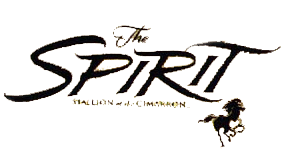

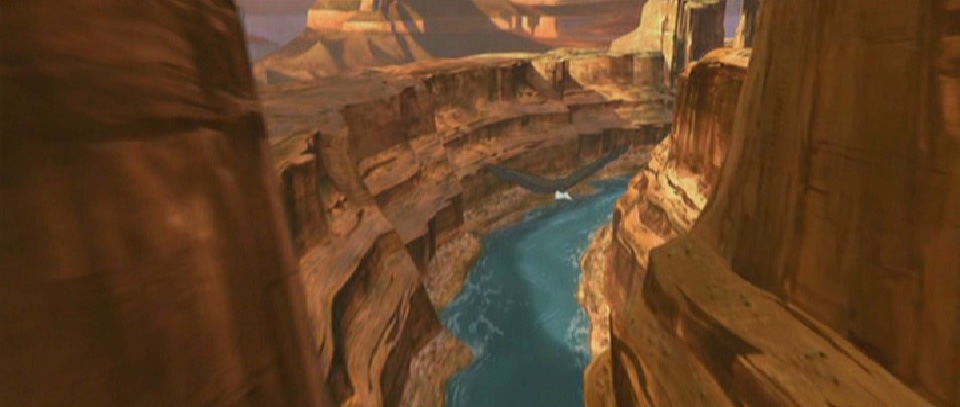 |
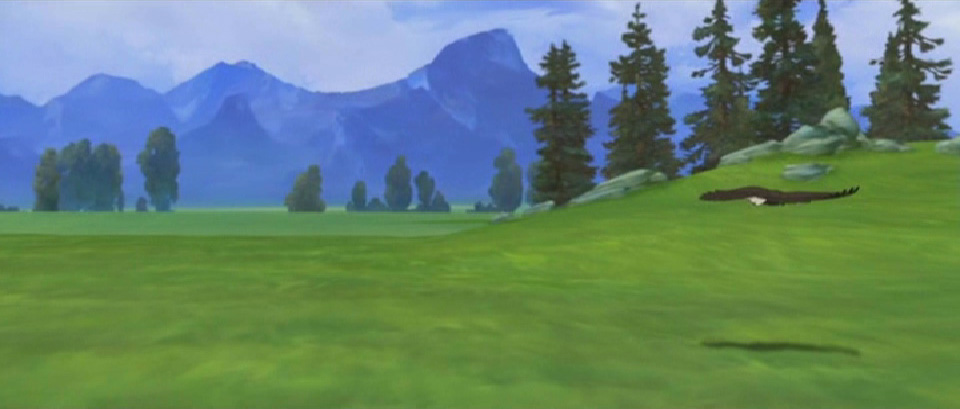 |
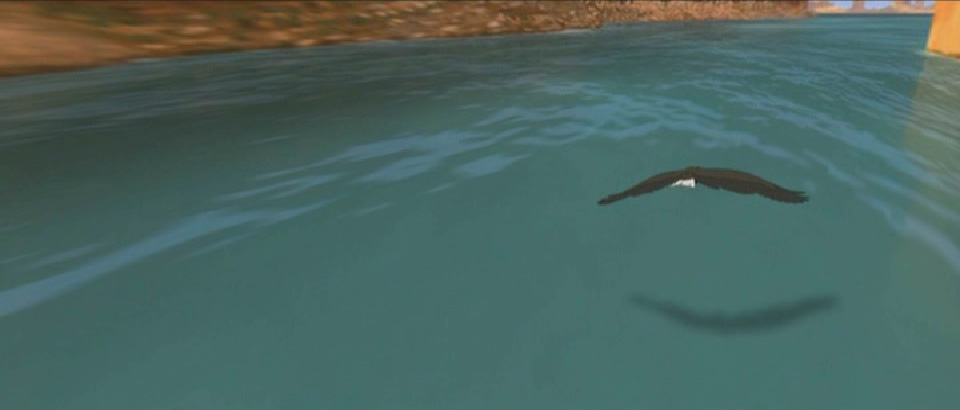 |
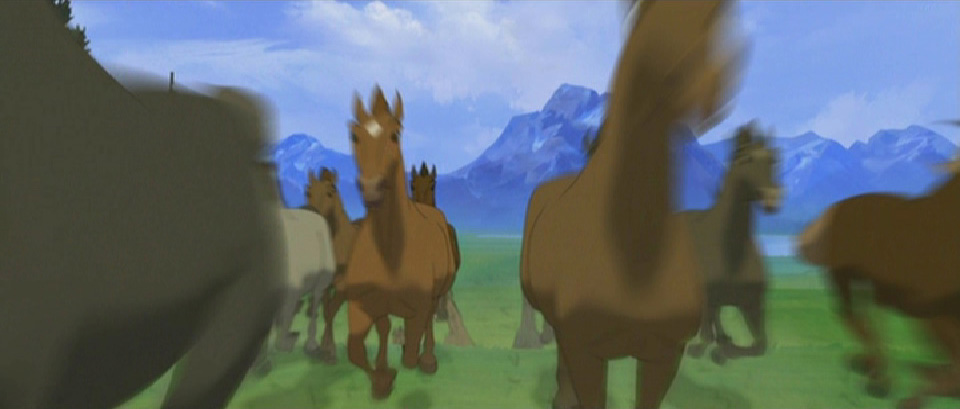 |
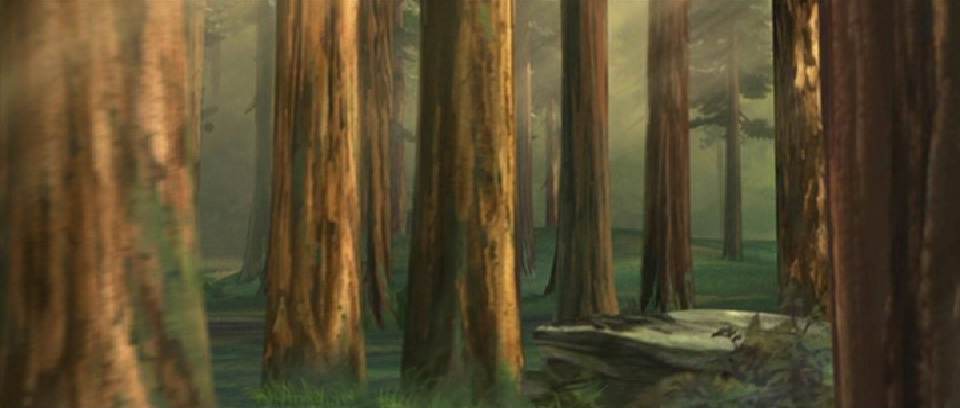 |
Directed by: Kelly Asbury & Lorna Cook
Written by: John Fusco
Music by: Hans Zimmer (score) and Bryan
Adams (songs)
Production Started On:
February 22, 1999
Released on: May 24th, 2002 (pushed back
from its original November 22, 2001 slot)
Running Time: 82 minutes
Budget: $48 million (officially, though
it was estimated at $80 million plus another $30 million in marketing cost)
U.S. Opening Weekend: $23.213 million
over 3,317 screens
Box-Office: $73.215 million in the U.S.,
$120.7 million worldwide
Video Revenue: $103.2 million in DVD and
VHS rentals and sales (with sales of nearly 6 million units)
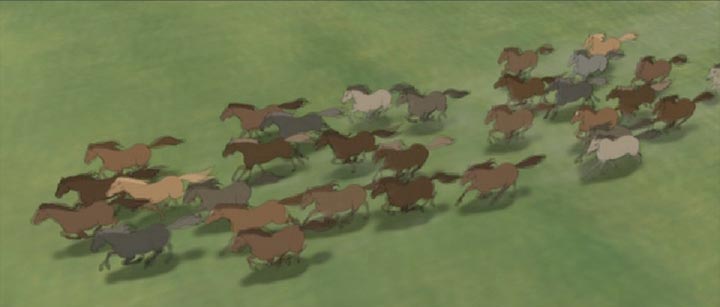 |
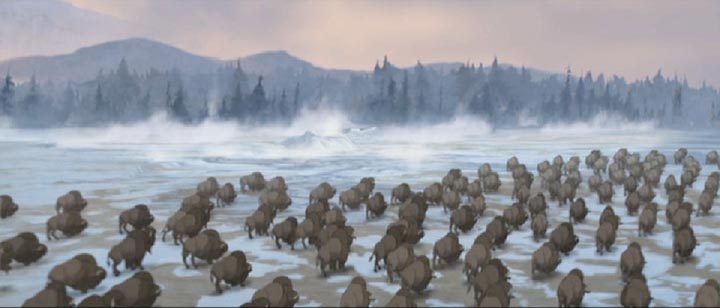 |
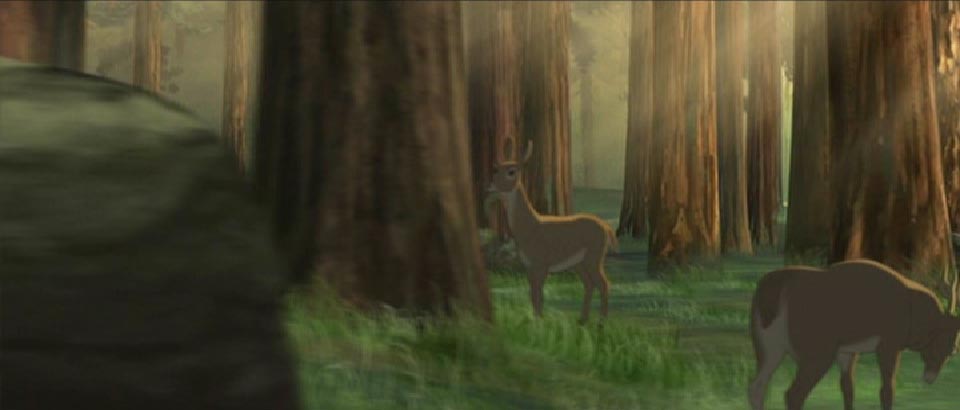 |
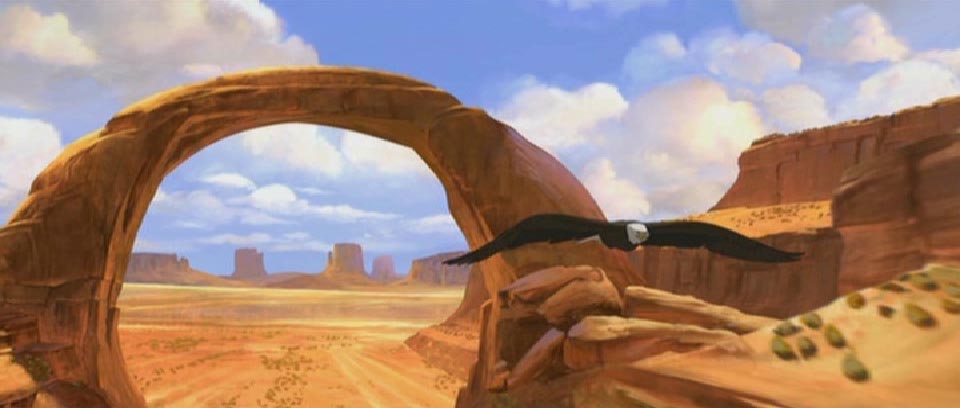 |
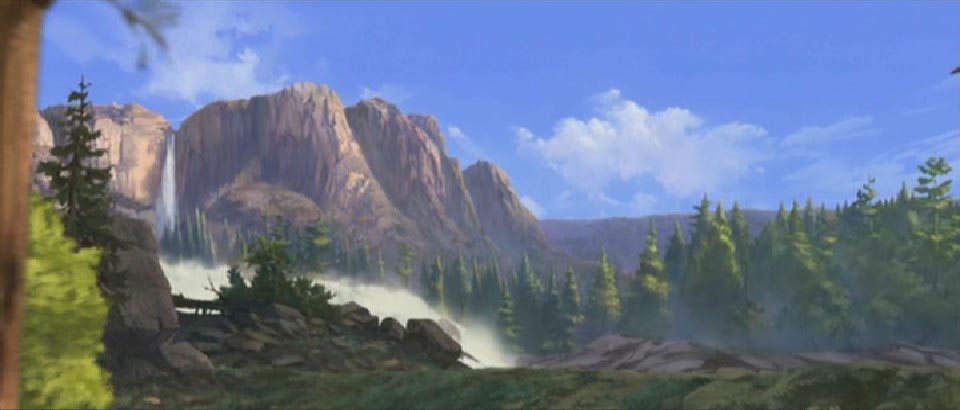 |
Cavalry Colonel... James Cromwell (Gene Hackman was reportedly
offered the part)
Little Creek... Daniel Studi
Narrator... Matt Damon
Bryan Adams
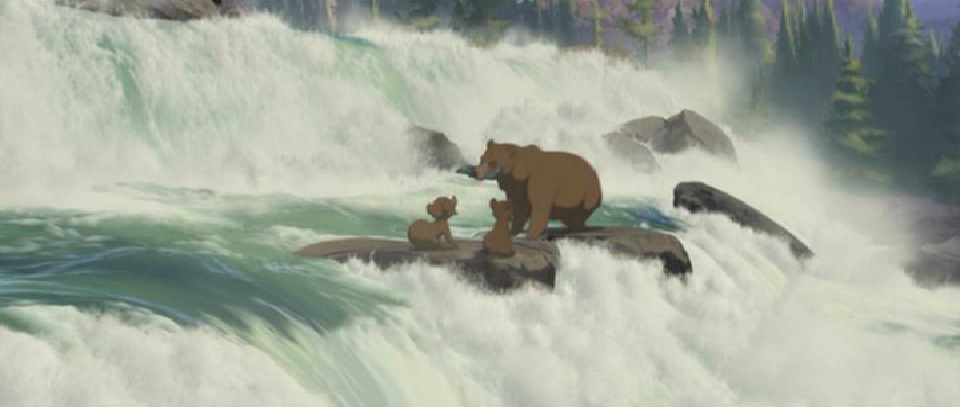 |
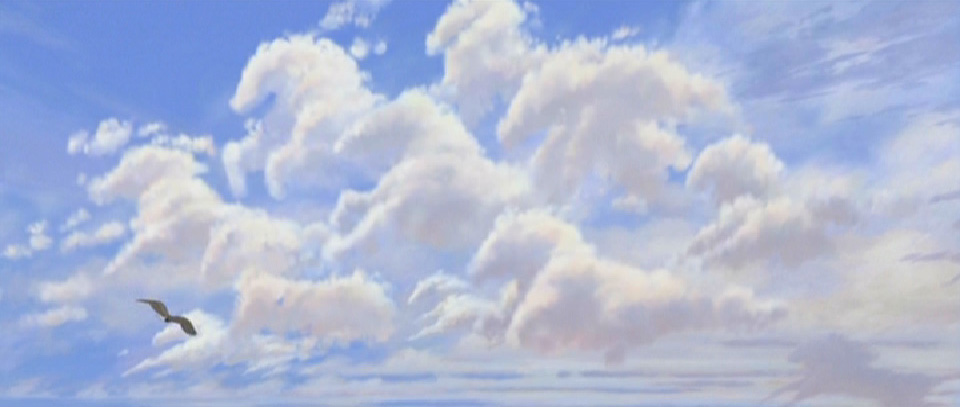 |
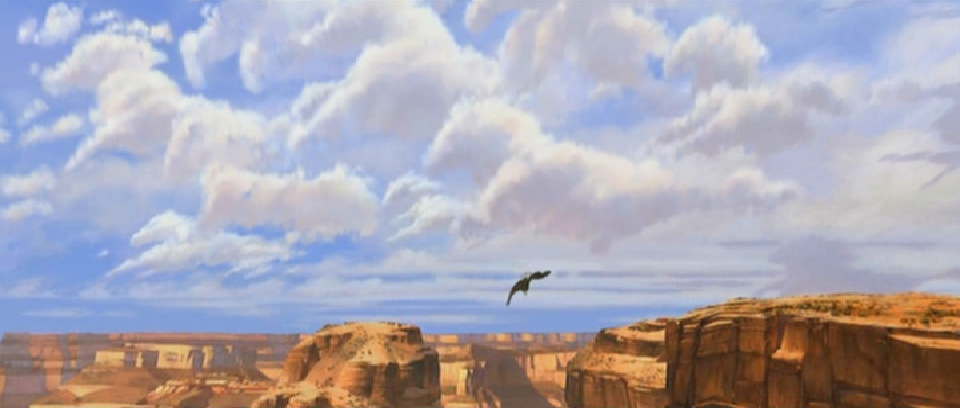 |
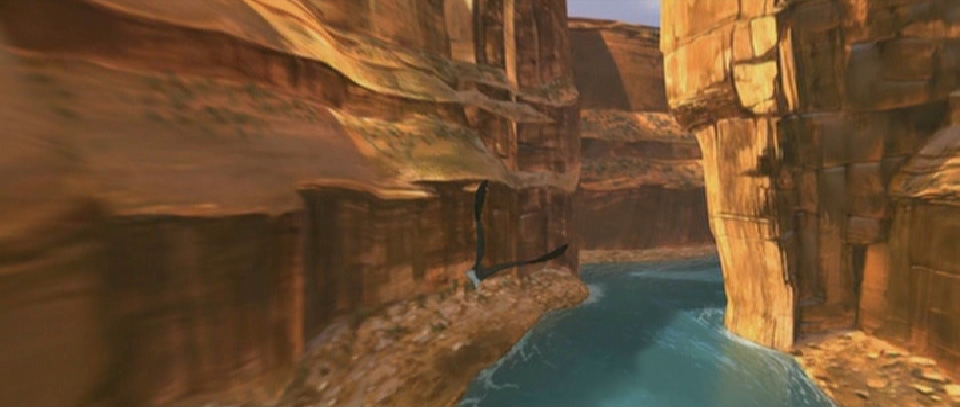 |
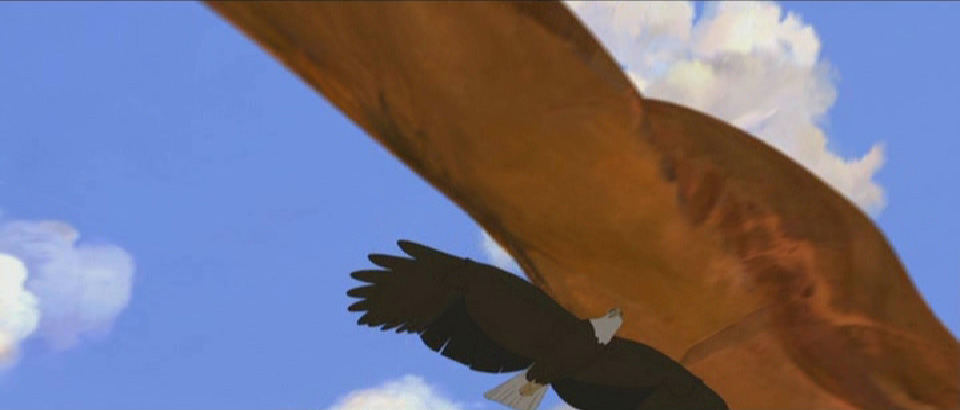 |
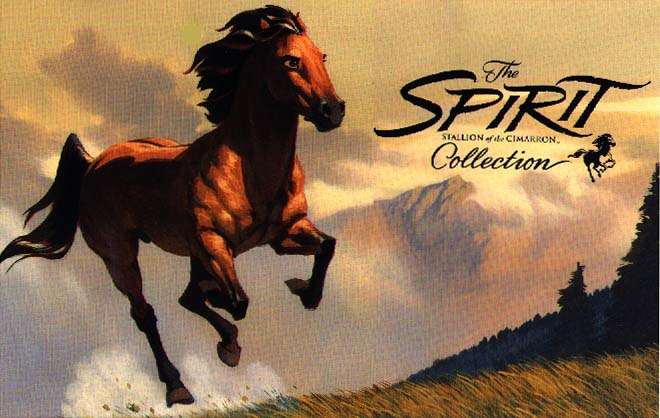 A
near-silent film set in America's Western Frontier in the 1800s, Spirits
is the rousing tale of a wild and rambunctious mustang stallion named Spirit
and his journey through the untamed American West. Along the way he falls
in love with a beautiful paint mare named Rain, develops a remarkable friendship
with a young Lakota brave, and becomes one of the greatest unsung heroes
of the Old West. Through the eyes of Spirit, we follow the
story of the westward movement, as the mustang runs free across
the American countryside and sees his life changed by the slow but inexorable
push of civilization in the wild. The film first introduces Spirit in the
freedom of the wild, only to have him caught by the cavalry and trained
to be a war horse.
A
near-silent film set in America's Western Frontier in the 1800s, Spirits
is the rousing tale of a wild and rambunctious mustang stallion named Spirit
and his journey through the untamed American West. Along the way he falls
in love with a beautiful paint mare named Rain, develops a remarkable friendship
with a young Lakota brave, and becomes one of the greatest unsung heroes
of the Old West. Through the eyes of Spirit, we follow the
story of the westward movement, as the mustang runs free across
the American countryside and sees his life changed by the slow but inexorable
push of civilization in the wild. The film first introduces Spirit in the
freedom of the wild, only to have him caught by the cavalry and trained
to be a war horse.
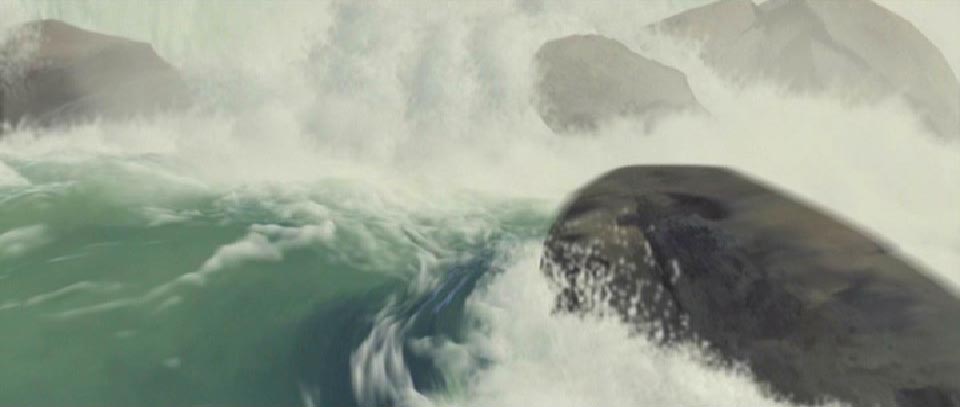 |
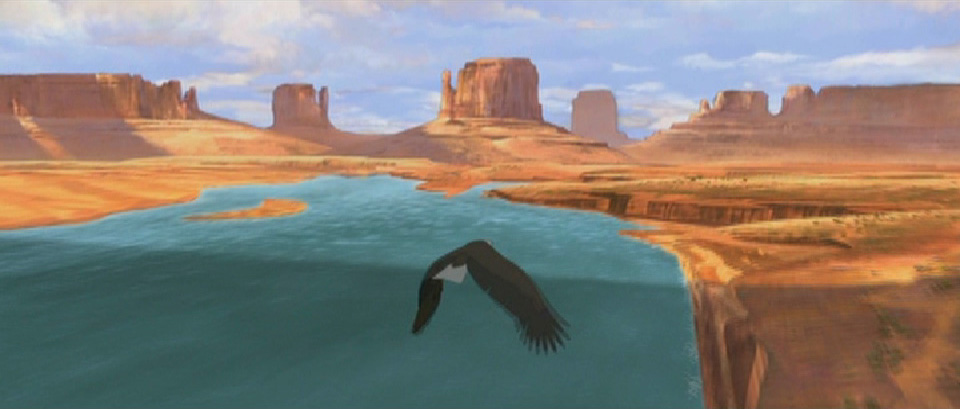 |
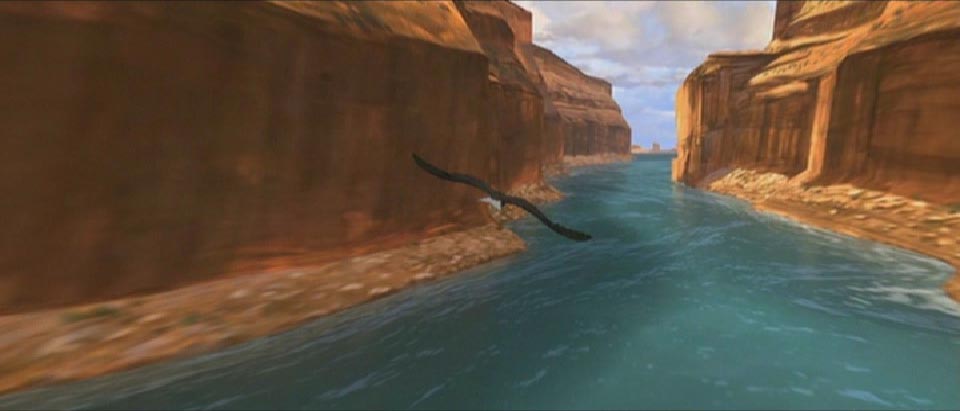 |
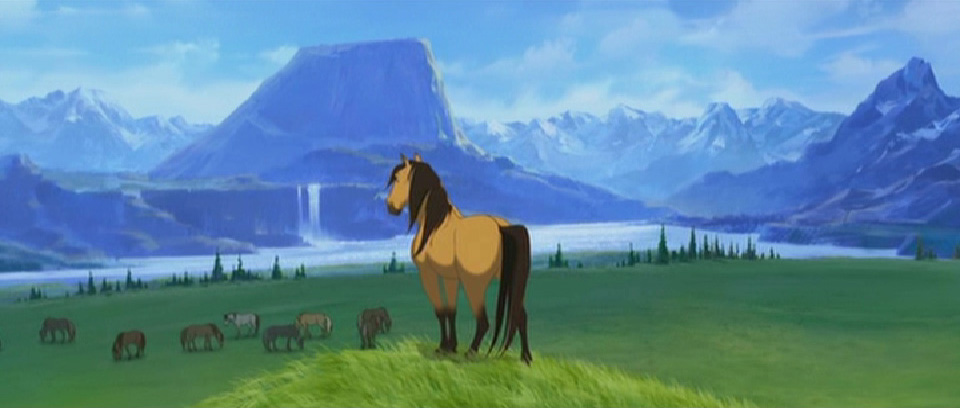 |
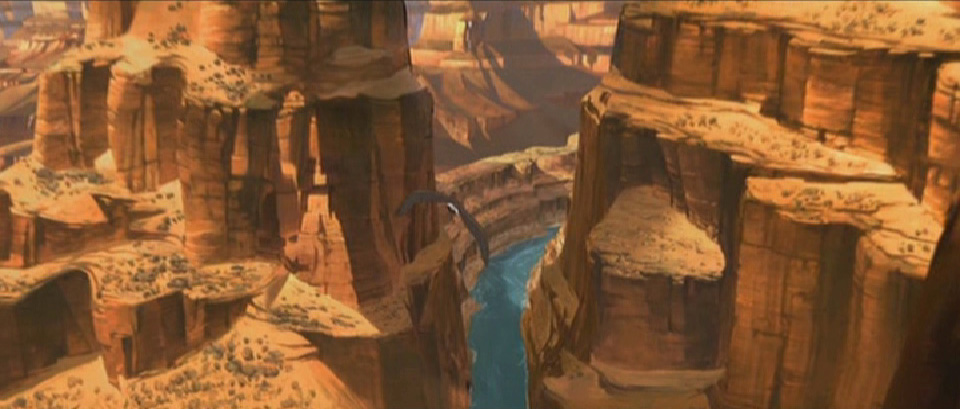 |
![]() A 2D/CG
composite coming from DreamWork's Glendale animation house, Katzenberg
calls Spirits "the return" to traditional animation's roots. He
went on to say that this is the project that he is currently most excited
about.
A 2D/CG
composite coming from DreamWork's Glendale animation house, Katzenberg
calls Spirits "the return" to traditional animation's roots. He
went on to say that this is the project that he is currently most excited
about.
![]() Though
official title is Spirit: Stallion of the Cimarron, it was also
named for a long time Spirit of the West, and went by the simpler
working title of Spirit.
Though
official title is Spirit: Stallion of the Cimarron, it was also
named for a long time Spirit of the West, and went by the simpler
working title of Spirit.
![]() The Cimarron
from Spirit's title is a medium-sized tailwater stream which flows
out of Eagle Nest Lake and is partially hidden in a beautiful canyon in
New Mexico's Sangre de Cristo Mountains.
The Cimarron
from Spirit's title is a medium-sized tailwater stream which flows
out of Eagle Nest Lake and is partially hidden in a beautiful canyon in
New Mexico's Sangre de Cristo Mountains.
![]() The
movie features photo-realistic horses set against panoramic vistas and
very little dialogue. The whole story will be told from the viewpoint
of the horse, with his thoughts heard as narrative.
The
movie features photo-realistic horses set against panoramic vistas and
very little dialogue. The whole story will be told from the viewpoint
of the horse, with his thoughts heard as narrative.
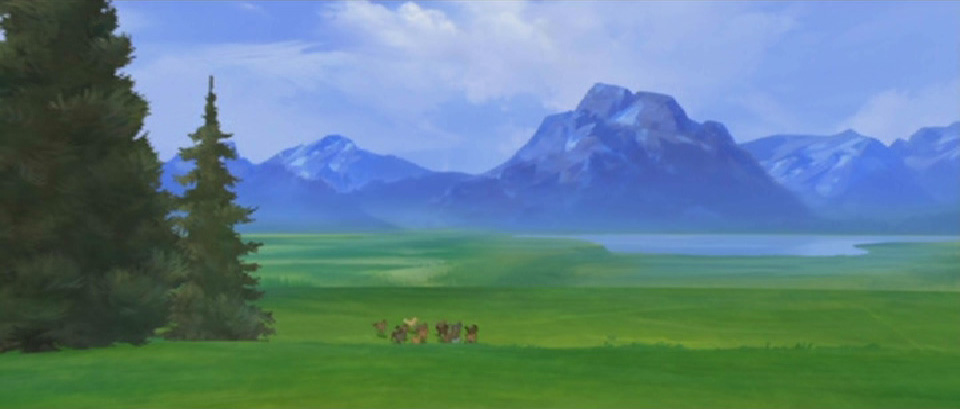
![]() This
is the first animated film shot in the very wide CinemaScope ratio format
(panoramic view) since Anastasia (1997).
This
is the first animated film shot in the very wide CinemaScope ratio format
(panoramic view) since Anastasia (1997).
![]() On April 3, 2000, Steven Spielberg managed to get a look at some footage
and was apparently leaping for joy over what he saw.
On April 3, 2000, Steven Spielberg managed to get a look at some footage
and was apparently leaping for joy over what he saw.
![]() DreamWorks
bought a Kiger Stallion named "Donner" from a rancher for $50,000 (which
is considered to be a high price). Donner will be used as the model for
the horse, Spirit in this film. Kiger Stallions are noteworthy because
they are a wild breed with traits that can be traced back to the breeds
brought over by the Spaniards in the 16th and 17th centuries. Donner was
most likely chosen so that DreamWorks can work off a horse that is most
like what a wild horse in the 18th century, like Spirit, might've looked
like.
DreamWorks
bought a Kiger Stallion named "Donner" from a rancher for $50,000 (which
is considered to be a high price). Donner will be used as the model for
the horse, Spirit in this film. Kiger Stallions are noteworthy because
they are a wild breed with traits that can be traced back to the breeds
brought over by the Spaniards in the 16th and 17th centuries. Donner was
most likely chosen so that DreamWorks can work off a horse that is most
like what a wild horse in the 18th century, like Spirit, might've looked
like.
![]() James
Baxter (already responsible for Belle, Rafiki, Quasimodo, Tulio and Moses
in the burning bush scene) will be animating the title character in Spirit.
James
Baxter (already responsible for Belle, Rafiki, Quasimodo, Tulio and Moses
in the burning bush scene) will be animating the title character in Spirit.
![]() The movie
was described by a first reviewer, in early July 2001, as more of an epic
western than a cartoon: "stylized without being overly cartoony", with
"some of the most beautiful horses ever seen in animation."
The movie
was described by a first reviewer, in early July 2001, as more of an epic
western than a cartoon: "stylized without being overly cartoony", with
"some of the most beautiful horses ever seen in animation."
![]() Though
horses do not talk -they "just whine and make horse noise"-, a Narrator
is the "voice" of Spirit.
Though
horses do not talk -they "just whine and make horse noise"-, a Narrator
is the "voice" of Spirit.
![]() John
McClane, the hero of the Die Hard movies, was a chief inspiration
for the wild horse who triumphs over adversity.
John
McClane, the hero of the Die Hard movies, was a chief inspiration
for the wild horse who triumphs over adversity.
![]() A teaser
for Spirit premiered on the Shrek
DVD in October 2001.
A teaser
for Spirit premiered on the Shrek
DVD in October 2001.
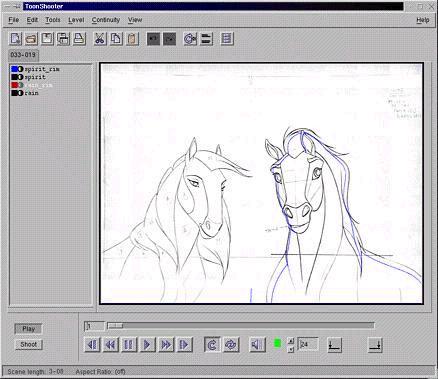
![]() A first trailer was shown at Siggraph in August 2001, at a panel about
the use of Linux at Dreamworks -who are using Linux exclusively for this
production. "It starts out with music (in a John Williams' style)
and a horse standing on a cliff, the clouds are in the shape of horses.
Then it pans over with an eagle/hawk flying over, follows the eagle/hawk
through the clouds, over the plains, into the canyons (Grand?) and the
narrator starts speaking, pans over the river in the canyon, then over
onto some mesas and finally to the herd of horses running . That's it for
any context. The narrator (first person/horse) says how many stories have
been told of how the West was won (or came to be) but never a story from
the horse's point of view. 'I remember when the horses ran free.... this
is that story.' "
A first trailer was shown at Siggraph in August 2001, at a panel about
the use of Linux at Dreamworks -who are using Linux exclusively for this
production. "It starts out with music (in a John Williams' style)
and a horse standing on a cliff, the clouds are in the shape of horses.
Then it pans over with an eagle/hawk flying over, follows the eagle/hawk
through the clouds, over the plains, into the canyons (Grand?) and the
narrator starts speaking, pans over the river in the canyon, then over
onto some mesas and finally to the herd of horses running . That's it for
any context. The narrator (first person/horse) says how many stories have
been told of how the West was won (or came to be) but never a story from
the horse's point of view. 'I remember when the horses ran free.... this
is that story.' "
![]() Head
of technology Ed Leonard says, "To dramatically reduce costs was one of
the big motivating factors in moving animators to Linux. But, it is our
animators' productivity that really counts. Telling the story well, not
the underlying technology, is what matters to us. Microsoft software continues
to play a key role in our overall business, but Linux is particularly well
suited to animation production pipelines.''
Head
of technology Ed Leonard says, "To dramatically reduce costs was one of
the big motivating factors in moving animators to Linux. But, it is our
animators' productivity that really counts. Telling the story well, not
the underlying technology, is what matters to us. Microsoft software continues
to play a key role in our overall business, but Linux is particularly well
suited to animation production pipelines.''
![]() Dreamworks
reportedly contacted both Bruce Springsteen and Paul Simon to write music
for this film, and Robert Redford to narrate it.
Dreamworks
reportedly contacted both Bruce Springsteen and Paul Simon to write music
for this film, and Robert Redford to narrate it.
![]() Bryan
Adams announced in an official update to fanclub members in December 2001
that he would be "the voice of the main character, a horse, in
Spirit:
Stallion Of The Cimarron." The Canadian singer made a trip to Los Angeles
over the summer and in early October 2001 to record his voice overs for
the movie. He also wrote songs with Mutt Lange and Gretchen Peters to name
a few, for the May 2002 soundtrack that is expected to contain "at least
11" of them -official releases mentioned only 6 to 8. Titles already known
include "Here I Am," "Get off of My Back," "Sound the Bugle" and "I Will
Always Return."
Bryan
Adams announced in an official update to fanclub members in December 2001
that he would be "the voice of the main character, a horse, in
Spirit:
Stallion Of The Cimarron." The Canadian singer made a trip to Los Angeles
over the summer and in early October 2001 to record his voice overs for
the movie. He also wrote songs with Mutt Lange and Gretchen Peters to name
a few, for the May 2002 soundtrack that is expected to contain "at least
11" of them -official releases mentioned only 6 to 8. Titles already known
include "Here I Am," "Get off of My Back," "Sound the Bugle" and "I Will
Always Return."
![]() Nevertheless,
and in spite of DreamWorks previously releasing a teaser trailer in Canada
featuring Bryan Adams' voice-over, it was officially announced in February
2002 that Matt Damon would be narrating the movie. "We spent four years
trying to find the perfect voice that could capture a spirited, heroic
character," said DreamWorks' animation overseer, Jeffrey Katzenberg. "Matt
had everything we hoped for, a genuine enthusiasm for life that comes through
melodically in his voice." Eight new songs written and sung by Bryan Adams
will indeed fill in the story blanks. Matt Damon met the real-life
model for Spirit in the horse flesh. "It was a beautiful thing, those two
together," said Katzenberg, who adds with a chuckle, "They did have a contest
over who was the bigger star."
Nevertheless,
and in spite of DreamWorks previously releasing a teaser trailer in Canada
featuring Bryan Adams' voice-over, it was officially announced in February
2002 that Matt Damon would be narrating the movie. "We spent four years
trying to find the perfect voice that could capture a spirited, heroic
character," said DreamWorks' animation overseer, Jeffrey Katzenberg. "Matt
had everything we hoped for, a genuine enthusiasm for life that comes through
melodically in his voice." Eight new songs written and sung by Bryan Adams
will indeed fill in the story blanks. Matt Damon met the real-life
model for Spirit in the horse flesh. "It was a beautiful thing, those two
together," said Katzenberg, who adds with a chuckle, "They did have a contest
over who was the bigger star."
![]() Jeffrey
Katzenberg noted during a ShoWest presentation in March 2002 that in the
successful wake of such movies as his own CGI-animated Shrek
and Pixar/Disney's Monsters, Inc.,
"pundits are sounding the death knell of 2-D animation," which could be
premature since "Spirit represents an attempt to revitalize a unique
and exceptional art form." The film, Katzenberg said, "is more complex
than Shrek but done in a way to make it invisible." Referring to
the competitive summer that is shaping up, Jeffrey Katzenberg said of Spirit:
"It has been made literally for every audience, every age group -- every
human will be able to see it after they've seen Spider-Man and Star
Wars."
Jeffrey
Katzenberg noted during a ShoWest presentation in March 2002 that in the
successful wake of such movies as his own CGI-animated Shrek
and Pixar/Disney's Monsters, Inc.,
"pundits are sounding the death knell of 2-D animation," which could be
premature since "Spirit represents an attempt to revitalize a unique
and exceptional art form." The film, Katzenberg said, "is more complex
than Shrek but done in a way to make it invisible." Referring to
the competitive summer that is shaping up, Jeffrey Katzenberg said of Spirit:
"It has been made literally for every audience, every age group -- every
human will be able to see it after they've seen Spider-Man and Star
Wars."
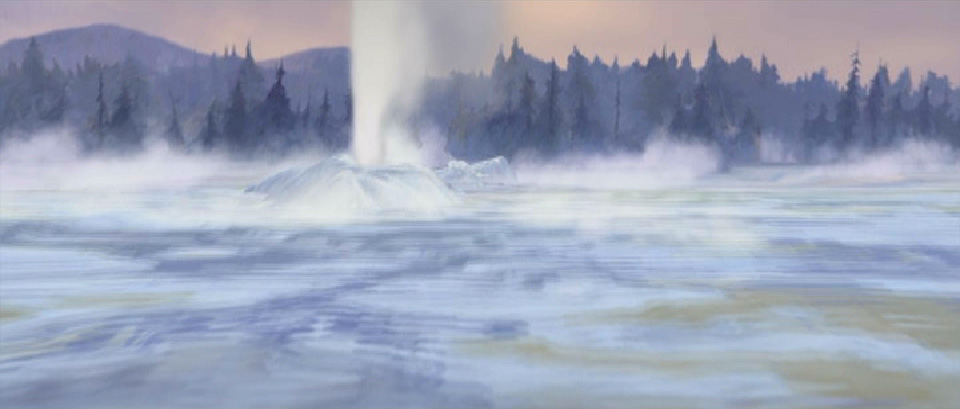 |
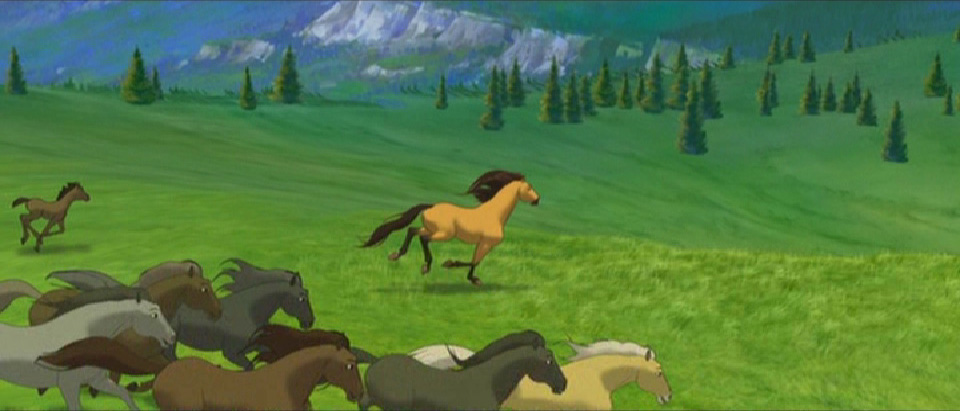 |
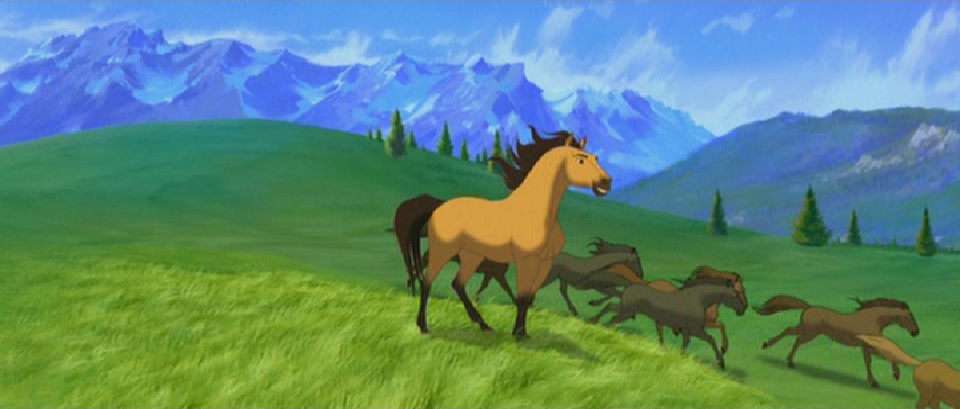 |
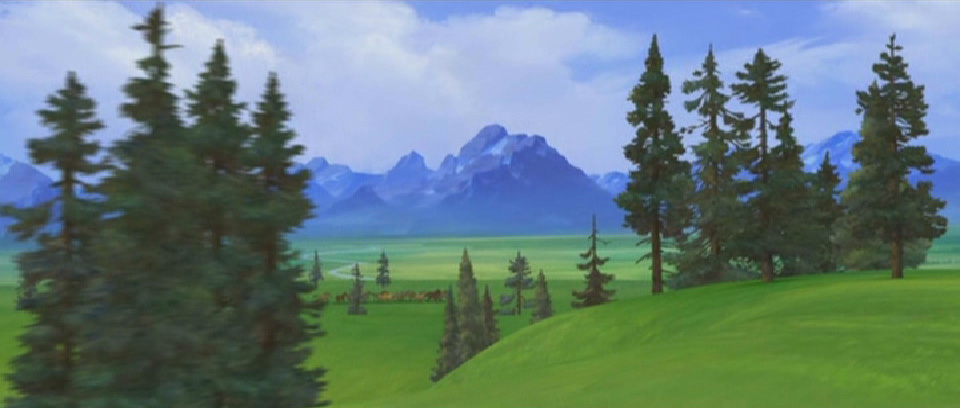 |
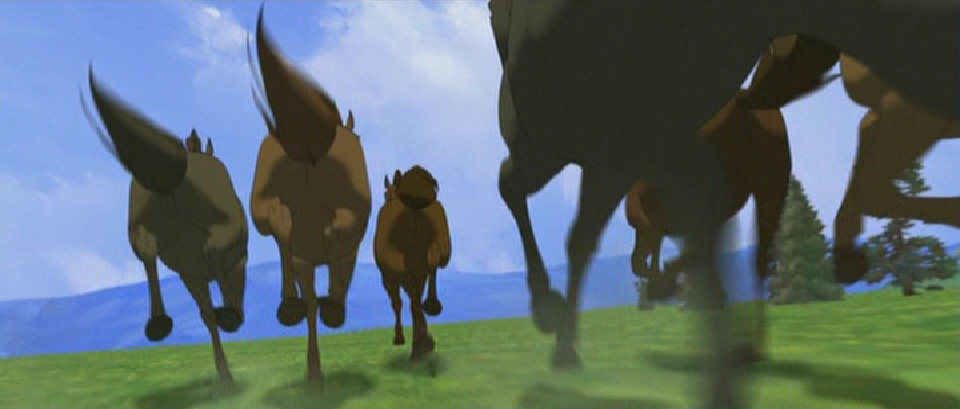 |
![]() Bryan
Adams commented that he hasn't "stopped making music as people keep implying.
Up to 1998, I did four albums in four years. Since then I've been doing
a lot of touring. Maybe it's a good thing Spirit came along. It'll
help put me back in the public eye." About the movie's May 18 world premiere
at the Cannes Film Festival, rocker Bryan Adams explains: "We'll be presenting
the entire film live to picture. I'll be on stage with a six-piece band
that includes (composer) Hans Zimmer. I'll be standing there singing the
songs. The Spirit soundtrack album is my new album. There are 16
tracks on it. Only six of those songs actually appear in the film. The
others are songs that never made the cut. There are probably five more
songs I wrote that didn't even make it onto the album. The whole project
was constantly in transition. In fact, they're still tweaking it." Adams
wrote the love ballad 'Don't Let Go' to underscore the relationship that
grows between Spirit and Rain, a mare owned by a young Native American
who helps him escape from the army compound. "I recorded the ballad with
Sarah McLachlan in Vancouver just shortly before she had her baby [India].
Even that one got cut from the film, but it appears during the end credits.
My favourite song, 'Brothers Under the Sun', didn't even make it into the
film, but it, too, is under the credits and is featured prominently on
the album."
Bryan
Adams commented that he hasn't "stopped making music as people keep implying.
Up to 1998, I did four albums in four years. Since then I've been doing
a lot of touring. Maybe it's a good thing Spirit came along. It'll
help put me back in the public eye." About the movie's May 18 world premiere
at the Cannes Film Festival, rocker Bryan Adams explains: "We'll be presenting
the entire film live to picture. I'll be on stage with a six-piece band
that includes (composer) Hans Zimmer. I'll be standing there singing the
songs. The Spirit soundtrack album is my new album. There are 16
tracks on it. Only six of those songs actually appear in the film. The
others are songs that never made the cut. There are probably five more
songs I wrote that didn't even make it onto the album. The whole project
was constantly in transition. In fact, they're still tweaking it." Adams
wrote the love ballad 'Don't Let Go' to underscore the relationship that
grows between Spirit and Rain, a mare owned by a young Native American
who helps him escape from the army compound. "I recorded the ballad with
Sarah McLachlan in Vancouver just shortly before she had her baby [India].
Even that one got cut from the film, but it appears during the end credits.
My favourite song, 'Brothers Under the Sun', didn't even make it into the
film, but it, too, is under the credits and is featured prominently on
the album."
![]() Composer
Hans Zimmer said that when he agreed to write the score for Dreamworks'
animated film Spirit: Stallion of the Cimarron, he insisted that
producer Jeffrey Katzenberg allowed him to see color footage from the film.
"I wasn't going to work on the movie unless I had color because in The
Lion King, I did most of the score to the stencil drawings and there are
colors that clash between the music and what the animators did. Not because
it's all their fault. Nobody notices it but it's like fingers on a blackboard
for me. Mr. Bryan Adams came to my rescue on this movie. We realized
at a certain point that dialogue wasn't really going to do it in this film
because it's the perspective of a horse and we didn't want to do the talking
animals thing. We'd done that one. There's only so much I can do instrumentally
and ultimately what I needed was a great communicator to come to my rescue
and Jeffrey suggested Bryan. It's not just about Bryan as a lyricist but
it's just Bryan as a performer. There's a reason people go and see Bryan's
shows and it's not just the dancing. He's a great actor and he literally
communicated the best that I could find for this. How do we pick [where
to have lyrics]? I wrote some music, Bryan wrote some lyrics. Suddenly,
so many new opportunities arose of how we could tell the story. So, we
just literally started shoving things around. I mean, we had a great love
song. We had a love song that Bryan wrote lyrics to five times and it's
not in the movie because we could never make it work. On the other hand,
the journey to the fort when he first gets captured never had a song, but
we had Bryan just do a scratch track one day. We knew that just his voice
could tell so much more of the story than instrumental stuff could ever
do. It was a discovery all the time." Bryan Adams adds his two cents:
"[Writing Spirit's music] became a matter of, don't say what you see, say
what you feel. It was like writing a love song without being able to ever
use the word love." Says Hans Zimmer: "Well, Jeffrey (Katzenberg)
always said to me that this was a huge experiment. I have 87 versions
of the opening score, though I guess that pain was mostly self-inflicted.
The very first thing I wrote is now at the end of the movie." Before concluding
on a positive note: "if you get the notes just right, they're like a laser
just honing in on the emotion. You can say a lot more than with dialogue."
Composer
Hans Zimmer said that when he agreed to write the score for Dreamworks'
animated film Spirit: Stallion of the Cimarron, he insisted that
producer Jeffrey Katzenberg allowed him to see color footage from the film.
"I wasn't going to work on the movie unless I had color because in The
Lion King, I did most of the score to the stencil drawings and there are
colors that clash between the music and what the animators did. Not because
it's all their fault. Nobody notices it but it's like fingers on a blackboard
for me. Mr. Bryan Adams came to my rescue on this movie. We realized
at a certain point that dialogue wasn't really going to do it in this film
because it's the perspective of a horse and we didn't want to do the talking
animals thing. We'd done that one. There's only so much I can do instrumentally
and ultimately what I needed was a great communicator to come to my rescue
and Jeffrey suggested Bryan. It's not just about Bryan as a lyricist but
it's just Bryan as a performer. There's a reason people go and see Bryan's
shows and it's not just the dancing. He's a great actor and he literally
communicated the best that I could find for this. How do we pick [where
to have lyrics]? I wrote some music, Bryan wrote some lyrics. Suddenly,
so many new opportunities arose of how we could tell the story. So, we
just literally started shoving things around. I mean, we had a great love
song. We had a love song that Bryan wrote lyrics to five times and it's
not in the movie because we could never make it work. On the other hand,
the journey to the fort when he first gets captured never had a song, but
we had Bryan just do a scratch track one day. We knew that just his voice
could tell so much more of the story than instrumental stuff could ever
do. It was a discovery all the time." Bryan Adams adds his two cents:
"[Writing Spirit's music] became a matter of, don't say what you see, say
what you feel. It was like writing a love song without being able to ever
use the word love." Says Hans Zimmer: "Well, Jeffrey (Katzenberg)
always said to me that this was a huge experiment. I have 87 versions
of the opening score, though I guess that pain was mostly self-inflicted.
The very first thing I wrote is now at the end of the movie." Before concluding
on a positive note: "if you get the notes just right, they're like a laser
just honing in on the emotion. You can say a lot more than with dialogue."
![]() Writer
John Fusco's original script was full of talking animals, but that the
movie eventually dropped the idea. "You start by writing it with full dialogue,
and then have [DreamWorks honcho] Jeffrey [Katzenberg] say, 'How about
no dialogue?'" Fusco said in an interview. "It's been four and a half years
and started off with talking horses and no talking humans. We followed
that direction for two years or so, until we had storyboards and sketches
to put up and animated sketches with the dialogue working. It was kind
of a group feeling that once the horses start talking, it breaks the spell,
and we're exploring some more realistic themes of the Old West here and
the end of the free West. Maybe we don't need the animals to speak. Maybe
we can do it with the voice of Spirit through narration." John Fusco described
the tone of his original talking-animal script. "I was partly influenced
by Orwell's Animal Farm, and the horses were very representative
of different cultures and ideas," Fusco said. "It was darker--a lot of
darker shades, and everyone was really excited about that. But it's gone
through quite an evolution. Then it became very heavy on narration, which
you know now, but Jeffrey asked me to overwrite narration on every scene
to really have Spirit tell his story, deliver his perspective on everything.
We would use that to inform songs and cut back just to the essence of the
narration. But it went from all talking animals to where it is now." For
his part, Katzenberg insists that he never intended for the horses to speak.
"We wanted to tell a story that was an emotional journey, as opposed to
an irreverent comedy," Katzenberg said. "The moment that decision was made
that we wanted to tell that kind of a story, as soon as you see a horse...
talk, it's Mr. Ed, and it didn't work. We never even tried it, because
in our mind it just suddenly made the movie undramatic." Kelly Asbury,
who co-directed Spirit, added, "The process of animation is a little
hard to explain. We use a script, and the script is very important to the
structure of the story and the contents of the scenes. When we storyboard
these films, we use the dialogue to help us in the storyboard phase to
know what the scene is about. As we slowly develop it, that dialogue comes
and goes. We wanted to be visual about it. The dialogue in his script was
the jump-off point. I guess that's how to put it."
Writer
John Fusco's original script was full of talking animals, but that the
movie eventually dropped the idea. "You start by writing it with full dialogue,
and then have [DreamWorks honcho] Jeffrey [Katzenberg] say, 'How about
no dialogue?'" Fusco said in an interview. "It's been four and a half years
and started off with talking horses and no talking humans. We followed
that direction for two years or so, until we had storyboards and sketches
to put up and animated sketches with the dialogue working. It was kind
of a group feeling that once the horses start talking, it breaks the spell,
and we're exploring some more realistic themes of the Old West here and
the end of the free West. Maybe we don't need the animals to speak. Maybe
we can do it with the voice of Spirit through narration." John Fusco described
the tone of his original talking-animal script. "I was partly influenced
by Orwell's Animal Farm, and the horses were very representative
of different cultures and ideas," Fusco said. "It was darker--a lot of
darker shades, and everyone was really excited about that. But it's gone
through quite an evolution. Then it became very heavy on narration, which
you know now, but Jeffrey asked me to overwrite narration on every scene
to really have Spirit tell his story, deliver his perspective on everything.
We would use that to inform songs and cut back just to the essence of the
narration. But it went from all talking animals to where it is now." For
his part, Katzenberg insists that he never intended for the horses to speak.
"We wanted to tell a story that was an emotional journey, as opposed to
an irreverent comedy," Katzenberg said. "The moment that decision was made
that we wanted to tell that kind of a story, as soon as you see a horse...
talk, it's Mr. Ed, and it didn't work. We never even tried it, because
in our mind it just suddenly made the movie undramatic." Kelly Asbury,
who co-directed Spirit, added, "The process of animation is a little
hard to explain. We use a script, and the script is very important to the
structure of the story and the contents of the scenes. When we storyboard
these films, we use the dialogue to help us in the storyboard phase to
know what the scene is about. As we slowly develop it, that dialogue comes
and goes. We wanted to be visual about it. The dialogue in his script was
the jump-off point. I guess that's how to put it."
![]() Anatomy
experts Deb Bennett, Director of the Equine Studies Institute; and paleontologist
Stuart Sumida, Associate Professor at California State University, San
Bernardino, acted as consultants throughout the mammoth animation process,
ensuring authenticity in the details. "One of the things that sets
this film apart," says Sumida, "is that the studio grounded everyone connected
with this project in real horse knowledge. The animators had to learn the
nuts and bolts of anatomy, of gait, of why the head is shaped the way it
is. They also had to be sensitized to the individual nuances of the horse."
Adds Bennett: "Such as learning how one breed differs from another. The
animators didn't know that. We brought in actual skeletons for them to
move and touch. Touching is very important, especially for artists. Understanding
how the joints work is essential to portraying movement correctly."
Anatomy
experts Deb Bennett, Director of the Equine Studies Institute; and paleontologist
Stuart Sumida, Associate Professor at California State University, San
Bernardino, acted as consultants throughout the mammoth animation process,
ensuring authenticity in the details. "One of the things that sets
this film apart," says Sumida, "is that the studio grounded everyone connected
with this project in real horse knowledge. The animators had to learn the
nuts and bolts of anatomy, of gait, of why the head is shaped the way it
is. They also had to be sensitized to the individual nuances of the horse."
Adds Bennett: "Such as learning how one breed differs from another. The
animators didn't know that. We brought in actual skeletons for them to
move and touch. Touching is very important, especially for artists. Understanding
how the joints work is essential to portraying movement correctly."
![]() "Horses
are notoriously difficult to draw, and a lot of people know how they look
and move, so it's obvious if you make a mistake," says James Baxter, supervising
animator of the title stallion. "Trying to create some of the actions in
the movie and give them enough power was tricky." Beyond the challenge
of drawing horses accurately, the animators had to create a horse who could
communicate with the audience through expressions and body language, as
the title character doesn't speak. Animators have usually avoided horse
characters because the distance between their eyes and mouths makes their
expressions hard to read. "It was a real challenge to give Spirit
a face that could display readable emotions," Baxter says. "We did some
design tricks, shifting his eyes a little further forward on the head,
so you can see both eyes more readily, which makes his expressions easier
to read. And we gave him nice big eyebrows--which horses don't have."
"Horses
are notoriously difficult to draw, and a lot of people know how they look
and move, so it's obvious if you make a mistake," says James Baxter, supervising
animator of the title stallion. "Trying to create some of the actions in
the movie and give them enough power was tricky." Beyond the challenge
of drawing horses accurately, the animators had to create a horse who could
communicate with the audience through expressions and body language, as
the title character doesn't speak. Animators have usually avoided horse
characters because the distance between their eyes and mouths makes their
expressions hard to read. "It was a real challenge to give Spirit
a face that could display readable emotions," Baxter says. "We did some
design tricks, shifting his eyes a little further forward on the head,
so you can see both eyes more readily, which makes his expressions easier
to read. And we gave him nice big eyebrows--which horses don't have."
![]() Jeffrey
Katzenberg explained that "In The Call of the Wild, author Jack
London told a story through the eyes of an animal. This was a big influence,
as was
Dances With Wolves. I found it exhilarating, and it gave
me the courage to ignore the rules and regulations that say this isn't
a practical choice."
Jeffrey
Katzenberg explained that "In The Call of the Wild, author Jack
London told a story through the eyes of an animal. This was a big influence,
as was
Dances With Wolves. I found it exhilarating, and it gave
me the courage to ignore the rules and regulations that say this isn't
a practical choice."
![]() Bryan
Adams joked that he "used Jeffrey [Katzenberg] as the direct motivation
for the rodeo song 'Get Off My Back.' That phrase became my mantra. I was
always trying to get Jeffrey off my back. He's a very hands-on
kind of guy that Jeffrey." For his part, Katzenberg says Adams "is
a bit of a wild stallion himself so you have to rein him in." For
Adams, that reining meant "if Jeffrey didn't think a song was right, it
was out. No discussion. It doesn't help one's ego to have a song
tossed into a bin." Not all the rejects hit the shredding machine.
Adams included several on the soundtrack album, which was released earlier
this month. "If they ever mount a Broadway version of Spirit,
I already have more material than they'd ever need." Adams says when
Katzenberg contacted him about the Spirit project, he assumed "I would
be attending some kind of casting call for songwriters. I was just pleased
they were holding the meetings in London." When he arrived at the
hotel to meet with Katzenberg there were no lineups around the block.
I asked what was going on and Jeffrey said 'You're it. Do you want to do
it or don't you?' Jeffrey said he came to me because he wanted the
horse to be like a rocker -- a wild, free spirited soul." Bryan Adams
also recalls that Katzenberg originally wanted him "to provide the voice-over
narration for the film but eventually, after two tries of different material,
I had to bow out of that and they turned it over to Matt Damon. "I'm
glad because I never liked the way I sounded on the narration. Maybe one
of those tracks will be on the bootleg DVD in Taiwan". One of the
songs that never made it into the body of the film is 'Don't Let Go', which
Adams eventually recorded with Sarah McLachlan. "That song was written
as the love ballad for Spirit and his girlfriend Rain. It's now under the
final credits. I thought it was so beautiful that it couldn't miss
being in the film but then I'm not the best judge of what songs are going
to be hits and which aren't. When I wrote 'Everything I Do' for Robin
Hood Prince of Thieves I thought it was a good B-side that's how much
I know about hits. Music is my life. It allowed me to run free so
maybe that's why I was able to identify with the horse in Spirit."
Bryan
Adams joked that he "used Jeffrey [Katzenberg] as the direct motivation
for the rodeo song 'Get Off My Back.' That phrase became my mantra. I was
always trying to get Jeffrey off my back. He's a very hands-on
kind of guy that Jeffrey." For his part, Katzenberg says Adams "is
a bit of a wild stallion himself so you have to rein him in." For
Adams, that reining meant "if Jeffrey didn't think a song was right, it
was out. No discussion. It doesn't help one's ego to have a song
tossed into a bin." Not all the rejects hit the shredding machine.
Adams included several on the soundtrack album, which was released earlier
this month. "If they ever mount a Broadway version of Spirit,
I already have more material than they'd ever need." Adams says when
Katzenberg contacted him about the Spirit project, he assumed "I would
be attending some kind of casting call for songwriters. I was just pleased
they were holding the meetings in London." When he arrived at the
hotel to meet with Katzenberg there were no lineups around the block.
I asked what was going on and Jeffrey said 'You're it. Do you want to do
it or don't you?' Jeffrey said he came to me because he wanted the
horse to be like a rocker -- a wild, free spirited soul." Bryan Adams
also recalls that Katzenberg originally wanted him "to provide the voice-over
narration for the film but eventually, after two tries of different material,
I had to bow out of that and they turned it over to Matt Damon. "I'm
glad because I never liked the way I sounded on the narration. Maybe one
of those tracks will be on the bootleg DVD in Taiwan". One of the
songs that never made it into the body of the film is 'Don't Let Go', which
Adams eventually recorded with Sarah McLachlan. "That song was written
as the love ballad for Spirit and his girlfriend Rain. It's now under the
final credits. I thought it was so beautiful that it couldn't miss
being in the film but then I'm not the best judge of what songs are going
to be hits and which aren't. When I wrote 'Everything I Do' for Robin
Hood Prince of Thieves I thought it was a good B-side that's how much
I know about hits. Music is my life. It allowed me to run free so
maybe that's why I was able to identify with the horse in Spirit."
![]() "He is
a partner," director Kelly Asbury says of Jeffrey Katzenberg. "He respects
us, and we respect him back. That's why he's been so successful with animation
over the years. We care so much, but he cares even more than us.
Where we would be satisfied, he wants an extra 5 percent." Katzenberg
would make suggestions about the smallest details, he says; in one scene,
the producer asked that an eyebrow be cocked a little more. For a film
in which the main character doesn't speak, "Those comments were invaluable."
And what of Katzenberg's dark side? "He didn't show us his dark side,"
director Lorna Cook says. "He treats us the way artists wish they could
be treated." Canadian rocker Bryan Adams agrees. "He wants it to
be great. He phoned me every day just to check in, to see if there's
anything I need. It's great to have someone with that kind of enthusiasm.
It makes you work harder."
"He is
a partner," director Kelly Asbury says of Jeffrey Katzenberg. "He respects
us, and we respect him back. That's why he's been so successful with animation
over the years. We care so much, but he cares even more than us.
Where we would be satisfied, he wants an extra 5 percent." Katzenberg
would make suggestions about the smallest details, he says; in one scene,
the producer asked that an eyebrow be cocked a little more. For a film
in which the main character doesn't speak, "Those comments were invaluable."
And what of Katzenberg's dark side? "He didn't show us his dark side,"
director Lorna Cook says. "He treats us the way artists wish they could
be treated." Canadian rocker Bryan Adams agrees. "He wants it to
be great. He phoned me every day just to check in, to see if there's
anything I need. It's great to have someone with that kind of enthusiasm.
It makes you work harder."
![]() Fully
aware that Spider-Man and Star Wars: Episode II Attack of the
Clones would be holding onto the coveted young-boy demographic, DreamWorks
executives decided they had to go after another, often overlooked group--teenage
girls. The studio was "all over this," said Laura Groppe, founder
of Girls Intelligence Agency, a girls marketing research group based in
Venice. Groppe said executives told her to "go for it, make it a girl movie."
So, she contracted to assist DreamWorks with its Spirit publicity.
Using the GIA
Internet site, GIA began spreading the word about Spirit. The company
coordinated screenings and writing contests about horses. Studio co-founder
Jeffrey Katzenberg even trekked to several events organized by GIA to discuss
the movie with hundreds of teenage girls around the nation. But DreamWorks'
strategy of targeting girls was something of a gamble in an industry where
high box office returns are driven primarily by 14-year-old boys. And it
appears the studio itself was somewhat divided over the decision--with
some executives (including Katzenberg) arguing that the film appeals as
much to young boys as young girls. Studio marketing executives, however,
felt they had little choice but to offer Spirit as counter-programming.
"When the competing product is Spider-Man and Star Wars,
a horse is probably the third choice for a boy. A horse is first choice
for a girl," said DreamWorks marketing chief, Terry Press. "Those of us
who were at Disney remember The Little
Mermaid, Beauty and the Beast
and Pocahontas, and know that you
can have success with girl-driven movies. The trap that you fall into is
trying to be all things for everybody these days. This time we decided
we are going to speak to our primary audience because they are underserved."
Fully
aware that Spider-Man and Star Wars: Episode II Attack of the
Clones would be holding onto the coveted young-boy demographic, DreamWorks
executives decided they had to go after another, often overlooked group--teenage
girls. The studio was "all over this," said Laura Groppe, founder
of Girls Intelligence Agency, a girls marketing research group based in
Venice. Groppe said executives told her to "go for it, make it a girl movie."
So, she contracted to assist DreamWorks with its Spirit publicity.
Using the GIA
Internet site, GIA began spreading the word about Spirit. The company
coordinated screenings and writing contests about horses. Studio co-founder
Jeffrey Katzenberg even trekked to several events organized by GIA to discuss
the movie with hundreds of teenage girls around the nation. But DreamWorks'
strategy of targeting girls was something of a gamble in an industry where
high box office returns are driven primarily by 14-year-old boys. And it
appears the studio itself was somewhat divided over the decision--with
some executives (including Katzenberg) arguing that the film appeals as
much to young boys as young girls. Studio marketing executives, however,
felt they had little choice but to offer Spirit as counter-programming.
"When the competing product is Spider-Man and Star Wars,
a horse is probably the third choice for a boy. A horse is first choice
for a girl," said DreamWorks marketing chief, Terry Press. "Those of us
who were at Disney remember The Little
Mermaid, Beauty and the Beast
and Pocahontas, and know that you
can have success with girl-driven movies. The trap that you fall into is
trying to be all things for everybody these days. This time we decided
we are going to speak to our primary audience because they are underserved."
![]() "We started
off with talking horses and no talking humans. And we followed that direction
for about two years or so." screenwriter Fusco said. In fact, his early
drafts of the script included a number of talking animals, including a
shaman-like white buffalo and one very wily coyote. "Eventually, it was
a group feeling that once the horses started talking it broke the spell.
And since we were trying to explore some realistic themes about the old
West, we thought maybe we don't need the animals to speak. Maybe we can
do it through the voice of a narrator and the character animation of the
horses." Animator James Baxter further explains that "the problem is horses
are harder to animate than many animals. They're much harder than a dog
or a cat because they don't have as many flexible parts to their bodies.
We had to boil down and simplify the anatomy into component parts. It's
not as if we tried to put in every muscle. But we had to understand where
they all were. Spirit's face is probably the most abstract part of him,
the most un-horse-like in terms of being accurate."
"We started
off with talking horses and no talking humans. And we followed that direction
for about two years or so." screenwriter Fusco said. In fact, his early
drafts of the script included a number of talking animals, including a
shaman-like white buffalo and one very wily coyote. "Eventually, it was
a group feeling that once the horses started talking it broke the spell.
And since we were trying to explore some realistic themes about the old
West, we thought maybe we don't need the animals to speak. Maybe we can
do it through the voice of a narrator and the character animation of the
horses." Animator James Baxter further explains that "the problem is horses
are harder to animate than many animals. They're much harder than a dog
or a cat because they don't have as many flexible parts to their bodies.
We had to boil down and simplify the anatomy into component parts. It's
not as if we tried to put in every muscle. But we had to understand where
they all were. Spirit's face is probably the most abstract part of him,
the most un-horse-like in terms of being accurate."
![]() "The
West at that time was a real survival world. And I wanted to show that,"
screenwriter John Fusco said. "In the early drafts the Colonel was Custer
and the idea was that the young Indian would become Crazy Horse. I wanted
to portray Custer and the 7th Cavalry as they were at the time, including
a scene depicting the Washington River massacre. It was a lot darker, and
in the beginning everyone was really excited about that." But as time went
by, the tone of the film began to take on a distinctly softer and lighter
tone, with many of Fusco's ideas cut out in the process. "I do believe
the finished version of the film is more politically correct. Films evolve.
They go in different directions. On a film like this you send in the draft
of a script, and in four months you get a call to come in and look at the
storyboards. That's when you realize the story's gone off in a different
direction. You've been working for two years and suddenly you're told,
'Guess what? No talking animals. We're going a different way.' Basically,
at that point you can sit there and argue. You can walk out. Or you can
say, 'All right, I'm in this and I'm going to stay. I'm going to make the
transition and work with it.'" Then laughing, Fusco added, "I don't really
think Jeffrey expected me to stay as long as I have. I think the idea was,
get John to come in, do a treatment, give us some Western flavor and go.
But I started getting excited watching the whole process. “When I look
at the finished film I still think that's Custer and that's Crazy Horse;
maybe someone else will read that into it, too. But what I really hope
is that the film will reach a lot of young people and light a fuse in them
to explore the history of the West."
"The
West at that time was a real survival world. And I wanted to show that,"
screenwriter John Fusco said. "In the early drafts the Colonel was Custer
and the idea was that the young Indian would become Crazy Horse. I wanted
to portray Custer and the 7th Cavalry as they were at the time, including
a scene depicting the Washington River massacre. It was a lot darker, and
in the beginning everyone was really excited about that." But as time went
by, the tone of the film began to take on a distinctly softer and lighter
tone, with many of Fusco's ideas cut out in the process. "I do believe
the finished version of the film is more politically correct. Films evolve.
They go in different directions. On a film like this you send in the draft
of a script, and in four months you get a call to come in and look at the
storyboards. That's when you realize the story's gone off in a different
direction. You've been working for two years and suddenly you're told,
'Guess what? No talking animals. We're going a different way.' Basically,
at that point you can sit there and argue. You can walk out. Or you can
say, 'All right, I'm in this and I'm going to stay. I'm going to make the
transition and work with it.'" Then laughing, Fusco added, "I don't really
think Jeffrey expected me to stay as long as I have. I think the idea was,
get John to come in, do a treatment, give us some Western flavor and go.
But I started getting excited watching the whole process. “When I look
at the finished film I still think that's Custer and that's Crazy Horse;
maybe someone else will read that into it, too. But what I really hope
is that the film will reach a lot of young people and light a fuse in them
to explore the history of the West."
![]() Animation director
Don
Bluth commented that he "liked the story and the fact that the horses
didn't talk. Didn't care for the Art Direction, blue skies, green grass,
brown dirt. Pretty ordinary. The dark sequences were the most artistic.
Hans Zimmer's score wasn't anything to write home about either. Some of
the songs worked well but not a home run. Terrific effort on the animators
part to bring it to life. Great opening weekend. So, marketing 'opened'
the film, but it doesn't seem to have 'legs.' The audience isn't responding
and not telling their friends to go see it. Doesn't look like it will make
it to the $100 mil mark. Too much fall-off after the first weekend. Dreamworks
hasn't seemed to given up though, we're still seeing advertising support.
Should do well in video market, especially with families with young girls."
Animation director
Don
Bluth commented that he "liked the story and the fact that the horses
didn't talk. Didn't care for the Art Direction, blue skies, green grass,
brown dirt. Pretty ordinary. The dark sequences were the most artistic.
Hans Zimmer's score wasn't anything to write home about either. Some of
the songs worked well but not a home run. Terrific effort on the animators
part to bring it to life. Great opening weekend. So, marketing 'opened'
the film, but it doesn't seem to have 'legs.' The audience isn't responding
and not telling their friends to go see it. Doesn't look like it will make
it to the $100 mil mark. Too much fall-off after the first weekend. Dreamworks
hasn't seemed to given up though, we're still seeing advertising support.
Should do well in video market, especially with families with young girls."
![]() Jeffrey Katzenberg
exulted in his first-ever Oscar nomination in February 2003, as a producer
of Spirit. The previous year, colleague Aron Warner got to be the
sole name representing the studio under Academy rules when Shrek
became the first winner in the new category. "Making Spirit was
a huge risk for everybody," Katzenberg said of the film, whose leads don't
speak. "It's genuinely thrilling to be nominated."
Jeffrey Katzenberg
exulted in his first-ever Oscar nomination in February 2003, as a producer
of Spirit. The previous year, colleague Aron Warner got to be the
sole name representing the studio under Academy rules when Shrek
became the first winner in the new category. "Making Spirit was
a huge risk for everybody," Katzenberg said of the film, whose leads don't
speak. "It's genuinely thrilling to be nominated."
![]() During a presentation
in Tokyo in February 2003, Jeffrey Katzenberg revealed that DreamWorks
was readying a Spirit sequel--but this one would be made to head
directly to video.
During a presentation
in Tokyo in February 2003, Jeffrey Katzenberg revealed that DreamWorks
was readying a Spirit sequel--but this one would be made to head
directly to video.
|
||||||||||||